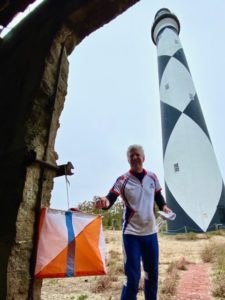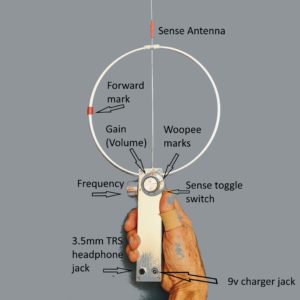A Beginner’s Guide to Radio-Orienteering
Radio-O, known as Amateur Radio Direction Finding (ARDF) was born during the cold war when when Northern and Eastern European countries wanted to encourage technical activities that developed civil defense skills in the schools and communities.
Classic Radio-O
The basic idea of a Radio-O classic event is to find up to 5 transmitters (sometimes called foxes) somewhere out in the woods. Each transmitter transmits a unique pattern of beeps for one minute and then the next transmitter comes on. So, once a transmitter stops transmitting you will need to wait 4 minutes for it to transmit again.
- Beep patterns of the transmitters, click to listen:
There is a visible orange and white orienteering flag close to each transmitter, and like in orienteering, when you find the flag (control) you punch in using your finger stick. Finding all of them will take you several km through the woods.
Maps
We use orienteering maps, which are much more detailed than USGS or military maps. Scale is usually 1:10,000. Small ditches and 1m boulders are shown on the map.

Receivers
You can get basic instruction on how to use the rental receiver to locate the transmitters at check-in. Please bring a simple pair of earbuds or headphones with a standard plug (not Bluetooth) so you can listen to the signal
How to use a receiver
- To turn on the receiver plug in your headphones.
- Turn the gain knob clockwise to the loudest setting.
- Turn the frequency knob slowly to find the frequency that is transmitting by listening for a series of beeps.
- The circular antenna can be used in two ways:
- sighting through the circle, and
- turning it edge on.
- Note that one side of the antenna has a forward mark.
- Locate the direction of a transmitter
- Hold the receiver so you are looking at the antenna edge on and the forward mark is away from you.
- Slowly turn your direction until the signal is loudest.
- You are now aimed either directly toward or away from the transmitter.
- Next flip the sense switch down and turn the antenna 180 degrees back and forth.
- The direction with the forward mark pointing to the loudest signal is the direction of the transmitter.
- Don’t forget to flip the sense switch back up.
- Planning your route on the map
- Finding the direction with the forward mark and the sense switch will give you an accuracy of about 10 degrees.
- Now you face the transmitter and turn the receiver so you are looking through the “O” of the antenna.
- You turn the receiver to the quietest sound and you can get a direction accuracy of about 3 degrees.
- You can now draw a line on your map from where you are along the bearing that you found.
- After you do that for all the transmitters you are going to take (you may not always be assigned all 5 transmitters), you can make a decision about the order you will find the transmitters.
- Later on, when you take bearings from another location you can get cross bearings which will give you a better sense of where the transmitter is.
- If you lose touch with where you are on the map you can find the controls by following the signal. Hopefully you will come across a feature you can identify to get your location on the map again.
- Finally, when you have found as many as you can within the time period you change the frequency to tune in the beacon, which is always on, to find your way to the finish.
Sprint
Radio-O Sprint ~2.5 k – The classic Radio-O sprint has two loops of 5 transmitters each, a spectator control, and a beacon. Each loop, the beacon and spectator control are different frequencies in the 80 meter band. The beacon and spectator control stay on continuously. The transmitters on the loops stay on for only 12 seconds before handing off to the next transmitter, so the whole cycle of 5 transmitters repeats each minute. First you find, in any order, the transmitters in the first loop; then you find the spectator control; then you find the transmitters, in any order, in the second loop; next you find the beacon; and finally punch in at the finish, which will be obvious from the beacon location. Sometimes the spectator control and beacon are the same transmitter. To qualify you must find at least one transmitter in each loop, the spectator and beacon. Score is first number of transmitters and then time.
FoxOring
FoxOring 3-8 k – FoxOring has a stronger orienteering component because the approximate locations of the transmitters are marked on the map. You use your orienteering skills navigate toward the location marked on the map. With your gain (volume) turned up all the way, you listen for a continuous always on beeping signal as you approach the map location. When you hear the signal you use that to home in to the actual location. The transmitter may be as far as 100m from the location marked on the map so listening for the signal is critical because there is no easily visible control, only the small SI-Box that you punch in with your finger stick will be near the tiny low power transmitter. Usually at BOK local events we just put the regular control flags on the ground under the transmitter. As in all the other events you can take the controls in any order, and results are calculated first by the number of transmitters you found and then ties are broken by time.


